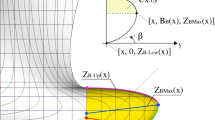Abstract
A computer-aided surface lofting, fairing and manufacturing program, called G-SURF, has been developed for, and successfully implemented in, a small shipyard. The interactive menu-driven package runs on an IBM-AT or equivalent personal computer and interfaces with standard three-dimensional wire frame drafting packages.
The naval architect's small scale design drawing is approximated by a minimum number of smooth three-dimensional skeletal-lines running along the entire length of the surface. The skeletal-lines are formed by parametric taut-cubic polynomial splines and represent the essential features of the hull form. These lines are normally the profile, shear, chine and intermediate lines as necessary and are individually adjusted in three-dimensional space until smooth. A set of station-lines is formed as required through the skeletal-lines to fully define the hull surface.
The hull can, if required, be lofted and faired as a developable surface that can be formed from flat sheet plate. The algorithms embodied in the program ensure developability and produce flat plate definition of the unwrapped hull form. The individual component plate shapes can be displayed on a graphics screen and interactively arranged to fit on a standard size of sheet plate material. During this ‘nesting’ process, the spacing between components, location of bridges, and direction, path and speed of cut are all specified.
Positional nested plate data are postprocessed to give G-code data for a plasma-arc plate burning machine. G-code machine instructions can be sent directly from the host computer via an RS-232C serial line to the machine tool or can be stored on a disk for later use. The storage and transmission of part programs avoids the medium of punched paper tape, is flexible, reliable and can handle large amounts of data.
Implementation of the G-SURF package has reduced the lofting, fairing and manufacturing time for ship hulls by a factor of three.
Similar content being viewed by others
References
G. W. Vickers and S. Bedi, ‘The definition and manufacture of compound curved surfaces using G-Surf’,Computers in Industry,6 (3), pp. 173–183, June 1985.
G. W. Vickers and S. Bedi, ‘The generation of smooth curved surfaces from sparse irregular data’, accepted for publicationASME, Computers in Mechanical Engineering.
C. deBoor, ‘A guide to splines’,Applied Mathematical Sciences,27, 1968.
I. D. Faux and M. J. Pratt,Computational Geometry for Design and Manufacture, Chichester, England: Ellis Horwood, 1983.
S. Bedi and G. W. Vickers, ‘Control of CNC machines by direct computer links’, submitted toSME, Journal of Manufacturing Systems, 1986.
Author information
Authors and Affiliations
Rights and permissions
About this article
Cite this article
Vickers, G.W., Bedi, S., Blake, D. et al. Computer-aided lofting, fairing and manufacturing in small shipyards. Int J Adv Manuf Technol 2, 79–90 (1987). https://doi.org/10.1007/BF02601494
Issue Date:
DOI: https://doi.org/10.1007/BF02601494




